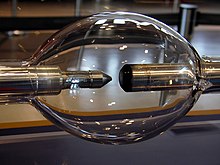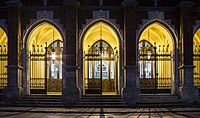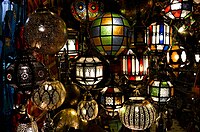Xenon arc lamp
This article needs additional citations for verification. (February 2012) |

A xenon arc lamp is a highly specialized type of
Types
Xenon
Each consists of a fused quartz or other heat resistant glass arc tube, with a tungsten metal electrode at each end. The glass tube is first evacuated and then re-filled with xenon gas. For xenon flashtubes, a third "trigger" electrode usually surrounds the exterior of the arc tube. The lifetime of a xenon arc lamp varies according to its design and power consumption, with a major manufacturer quoting average lifetimes ranging from 500 hours (7kW) to 1,500 (1kW).[1]
History

Interest in the xenon discharge was first aroused by P. Schulz in 1944, following his discovery of its near-continuous spectrum and high colour rendering white light.[2] Owing to wartime limitations on the availability of this noble gas, significant progress was not made until John Aldington[3] of the British Siemens lamp company published his research in 1949.[4]
This triggered intensive efforts at the German Osram company to further develop the technology as a replacement for carbon arcs in cinema projection. The xenon lamp promised tremendous advantages of a more stable arc with less flicker, and its non-consumable electrodes allowed longer films to be shown without interruptions. Osram's primary contribution to this achievement was its thorough research of xenon discharge physics, which directed its developments towards very short arcs for DC operation with a particular electrode and bulb geometry. The cathode is kept small to reach high temperatures for thermionic emission, the anode being larger to dissipate the heat generated as incoming electrons are decelerated. Most light is generated immediately in front of the cathode tip, where arc temperatures reach 10,000°C. The plasma is accelerated towards the anode and stabilised by the electrode shapes plus intrinsic magnetic compression generated by the current flow, and convection effects controlled by the bulb shape.
Following these developments, the first successful public projection using xenon light was performed on 30 October 1950, when excerpts from a colour film (
Modern usage
The white continuous light generated by the xenon arc is spectrally similar to daylight, but the lamp has a rather low
The very small size of the arc makes it possible to focus the light from the lamp with moderate precision. For this reason, xenon arc lamps of smaller sizes, down to 10 watts, are used in optics and in precision illumination for microscopes and other instruments, although in modern times they are being displaced by single mode laser diodes and white light supercontinuum lasers which can produce a truly diffraction-limited spot. Larger lamps are employed in searchlights where narrow beams of light are generated, or in film production lighting where daylight simulation is required.
All xenon short-arc lamps generate substantial
Many lamps have a
Lamp construction


All modern xenon short-arc lamps use a fused quartz envelope with
Because of the very high power levels involved, large lamps are water-cooled. In those used in IMAX projectors, the electrode bodies are made from solid Invar and tipped with thoriated tungsten. An

To achieve maximum efficiency, the xenon gas inside short-arc lamps is maintained at an extremely high pressure — up to 30 atmospheres (440 psi / 3040 kPa) — which poses safety concerns. If a lamp is dropped or ruptures while in service, pieces of the lamp envelope can be thrown at high speed. To mitigate this, large xenon short-arc lamps are normally shipped in protective shields, which will contain the envelope fragments should breakage occur. Normally, the shield is removed once the lamp is installed in the lamp housing. When the lamp reaches the end of its useful life, the protective shield is put back on the lamp, and the spent lamp is then removed from the equipment and discarded. As lamps age, the risk of failure increases, so bulbs being replaced are at the greatest risk of explosion. Lamp manufacturers recommend the use of eye protection when handling xenon short-arc lamps. Some lamps, especially those used in IMAX projectors, require the use of full-body protective clothing.
Light generation mechanism

Xenon short-arc lamps come in two distinct varieties: pure xenon, which contains only xenon gas; and xenon-mercury, which contains xenon gas and a small amount of mercury metal.
Pure xenon
In a pure xenon lamp, the majority of the light is generated within a tiny, pinpoint-sized cloud of plasma situated where the electron stream leaves the face of the cathode. The light generation volume is cone-shaped, and the luminous intensity falls off exponentially moving from cathode to anode. Electrons passing through the plasma cloud strike the anode, causing it to heat. As a result, the anode in a xenon short-arc lamp either has to be much larger than the cathode or be water-cooled, to dissipate the heat. The output of a pure xenon short-arc lamp offers fairly continuous spectral power distribution with a color temperature of about 6200K and color rendering index close to 100.[10] However, even in a high pressure lamp there are some very strong emission lines in the near infrared, roughly in the region from 850–900 nm. This spectral region can contain about 10% of the total emitted light.[citation needed] Light intensity ranges from 20,000 to 500,000 cd/cm2. An example is the "XBO lamp", which is an OSRAM trade name for a pure xenon short-arc lamp.[10]
For some applications, such as endoscopy and dental technology, light guide systems are included.
Xenon-mercury

As in a pure xenon lamp, the majority of the light produced radiates from a pinpoint-sized cloud of plasma near the face of the cathode. However, the plasma cloud in a xenon-mercury lamp is often smaller than that of a pure xenon lamp of equivalent size, due to the electron stream losing its energy more rapidly to the heavier mercury atoms. Xenon-mercury short-arc lamps have a bluish-white spectrum and extremely high UV output. These lamps are used primarily for UV curing applications, sterilizing objects, and generating ozone.
Ceramic xenon lamps

Xenon short-arc lamps also are manufactured with a ceramic body and an integral reflector. They are available in many output power ratings with either UV-transmitting or blocking windows. The reflector options are parabolic (for collimated light) or elliptical (for focused light). They are used in a wide variety of applications, such as video projectors, fiber optic illuminators, endoscope and headlamp lighting, dental lighting, and search lights.
Power supply requirements

Xenon short-arc lamps have a
Xenon long-arc-lamps
These are structurally similar to short-arc lamps except that the distance between the electrodes in glass tube is greatly elongated. When mounted within an
Though not commonly known outside of Russia and the former Soviet satellite countries, long arc xenon lamps were used for general illumination of large areas such as rail stations, sports arenas, mining operations, and nuclear power plant high bay spaces. These lamps, Лампа ксеноновая ДКСТ, literally "lamp xenon DKST" were characterized by high wattages ranging from 2kW to 100 kW. The lamps operated in a peculiar discharge regime where the plasma was thermalized, that is, the electrons were not significantly hotter than the gas itself. Under these conditions a positive current-voltage curve was demonstrated. This allowed the larger common sizes such as 5 and 10kW to operate directly from mains AC at 110 and 220 volts respectively without a ballast – only a series igniter was necessary to start the arc.
The lamps produced around 30 lumens/watt, which is about double the efficiency of the tungsten incandescent lamp, but less than more modern sources such as metal halide. They had the advantage of no mercury content, convective air cooling, no high pressure rupture risk, and nearly perfect color rendition. Due to low efficiency and competition from more common lamp types, few installations remain today, but where they do, they can be recognized by a characteristic rectangular/elliptical reflector, and crisp blue-white light from a relatively long tubular source.
See also
References
- ^ "Ushio - product data page". 2017-04-18.
- ^ Edelgasbögen, P.Schulz, Reichsbericht f.Physik, Vol.1 (1944) p147
- ^ "Dr. John Norman Aldington".
- ^ Gas Arcs, J.N. Aldington, Transactions of the Illuminating Engineering Society of London, Vol.14 (1949) pp19-51.
- ^ Die Neuen Xenon-Hochdrucklampen, K. Ittig, K. Larché, F. Michalk, Technisch-wissenschaftliche Abhandlungen der Osram-Gesellschaft, Vol.6 (1953) pp33-38.
- ^ Technik der Spezial-Entladungslampen, publ. Osram GmbH 1989, p24.
- ^ "Osram-Stud Short Arc Xenon XBO1001".
- ^ "Christie announces installation of laser projectors".
- ^ "Example of article discussing laser illumination replacing the xenon arc". 2014-02-22.
- ^ a b "OSRAM SYVLANIA XBO" (PDF). Archived from the original (PDF) on 2013-07-18.



